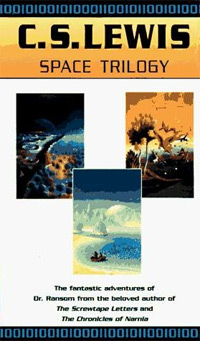
TL;DR
The Space Trilogy, sometimes referred to as The Cosmic Trilogy or The Ransom Trilogy, is a trilogy of three science fiction novels by C. S. Lewis, famous for his later series The Chronicles of Narnia. A philologist named Elwin Ransom is the hero of the first two novels and an important character in the third.
The books in the trilogy are:
* Out of the Silent Planet (1938), set mostly on Mars
* Perelandra (1943), set mostly on Venus. Also known as Voyage to Venus
* That Hideous Strength (1945), set on Earth. In 1958, the publishing house Avon (now an imprint of HarperCollins) published a version called The Tortured Planet from which they had cut one-third of the book.
Introduction to The Space Trilogy
Before The Chronicles of Narnia, C.S. Lewis crafted another masterful series: The Space Trilogy. Also known as The Cosmic Trilogy or The Ransom Trilogy, these three science fiction novels explore deep philosophical, theological, and moral themes, all woven into gripping tales of interplanetary adventure.
Set across Earth, Mars (Malacandra), Venus (Perelandra), and beyond, The Space Trilogy presents a cosmic vision of good versus evil, delving into the nature of humanity, the corruption of science, and the resistance of truth against deception. Though different in tone from Narnia, it shares many thematic and imaginative connections with Lewis’s better-known fantasy world.
If you love The Chronicles of Narnia for their exploration of good and evil, moral courage, and profound wonder, The Space Trilogy offers a richer, more adult exploration of similar ideas.
The Three Books of the Space Trilogy
Out of the Silent Planet (1938)
The first book follows Dr. Elwin Ransom, a philologist, who is abducted and taken to Malacandra (Mars). There, he discovers a beautiful world of peaceful creatures and divine order.
Key themes:
- The fallenness of Earth (called “the Silent Planet”).
- The harmony of unfallen worlds.
- The idea that evil is not universal.
Ransom must navigate betrayal, survival, and spiritual discovery, learning that humanity is not the center of the universe.
Perelandra (1943)
In the second book, Ransom is sent to Perelandra (Venus), a new world at the dawn of its creation. There, he must prevent a second “fall”—similar to the fall of Adam and Eve—by combating an evil influence sent from Earth.
Key themes:
- Temptation and free will.
- The beauty of obedience and trust.
- Spiritual warfare in a mythic, cosmic sense.
Perelandra is often described as Lewis’s most beautiful and poetic novel, filled with lush imagery and profound theological insights.
That Hideous Strength (1945)
The final book brings the conflict back to Earth, where a sinister organization called N.I.C.E. (National Institute for Coordinated Experiments) seeks to dominate humanity through science and bureaucracy. Ransom leads a small community of faithful resistors.
Key themes:
- Corruption of science and politics.
- The spiritual battle for Earth.
- The importance of humility and truth.
Set in England, That Hideous Strength is darker and more grounded than the earlier books but no less cosmic in its stakes. It connects the philosophical ideas of the earlier novels with the practical, everyday dangers of modern society.
Themes and Connections to Narnia
Though The Space Trilogy is science fiction rather than fantasy, it shares many deep thematic connections with The Chronicles of Narnia:
- Moral Allegory – Both series explore sin, redemption, temptation, and spiritual warfare.
- Mythic Storytelling – Lewis draws on classical, medieval, and Christian traditions to shape both worlds.
- Aslan and Maleldil – In The Space Trilogy, Maleldil (the divine being) fulfills a role similar to Aslan, representing divine love and order.
- Journey and Transformation – Characters in both series undergo spiritual growth through extraordinary journeys.
For fans of Narnia, reading The Space Trilogy can feel like peering into a more complex, adult mirror of the same cosmic struggle between good and evil.
Why Narnia Fans Might Enjoy It
- If you love the spiritual depth behind Aslan’s appearances, you’ll find similar depth in Maleldil’s cosmic order.
- If you admire the beauty of Narnia’s world-building, you’ll appreciate the vivid, imaginative landscapes of Malacandra and Perelandra.
- If you are drawn to Lewis’s profound moral insights, The Space Trilogy will offer even richer philosophical exploration.
While The Space Trilogy is more challenging and nuanced than Narnia, it rewards readers with one of C.S. Lewis’s greatest imaginative achievements.
Explore the Books
Click below to dive deeper into each book:
Each novel offers new layers of meaning and wonder, inviting you into Lewis’s grand cosmic vision.

Be the first to comment